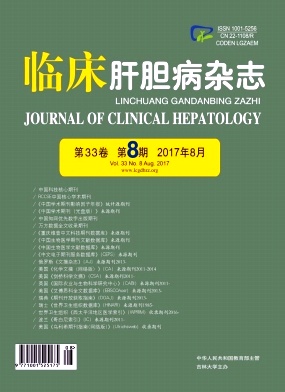|
[1]WANG BQ, XUE F, TONG Q, et al.Recurrence-free survival and overall survival in patients with hepatitis B-related liver cancer receiving antiviral therapy[J].J Pract Hepatol, 2015, 18 (2) :132-135. (in Chinese) 王伯庆, 薛峰, 佟庆, 等.抗病毒治疗对乙型肝炎相关肝癌根治术后复发和生存的影响[J].实用肝脏病杂志, 2015, 18 (2) :132-135.
|
|
[2]WU YJ, GUO JS.Hepatic stellate cells, Toll-like receptor 4 signaling pathway, and inflammatory fibrotic microenvironment in the development of hepatocellular carcinoma[J].J Clin Hepatol, 2015, 31 (6) :876-879. (in Chinese) 吴玉婧, 郭津生.肝星状细胞、Toll样受体4信号途径、炎症及纤维化微环境与原发性肝癌发生发展的关系[J].临床肝胆病杂志, 2015, 31 (6) :876-879.
|
|
[3]ZHOU RR, DENG YD, YUAN H.Epidemiological and clinical features of primary liver cancer:an analysis of 236 patients[J].J Clin Hepatol, 2016, 32 (8) :1538-1542. (in Chinese) 赵荣荣, 邓永东, 袁宏.236例原发性肝癌患者流行病学及临床特点分析[J].临床肝胆病杂志, 2016, 32 (8) :1538-1542.
|
|
[4]BAUMERT TF, JHLING F, ONO A, et al.Hepatitis C-related hepatocellular carcinoma in the era of new generation antivirals[J].BMC Med, 2017, 15 (1) :52.
|
|
[5]KANDA T, IMAZEKI F, MIKAMI S, et al.Occurrence of hepatocellular carcinoma was not a rare event during and immediately after antiviral treatment in Japanese HCV-positive patients[J].Oncology, 2011, 80 (5-6) :366-372.
|
|
[6]WEI MQ, DONG YH.The effect of antiviral therapy on tumcr recurrence after radical surgery for liver cancer[J].Int J Virol, 2015, 22 (3) :199-201. (in Chinese) 魏明琴, 董佑红.肝癌根治术后抗病毒治疗对肿瘤复发率的影响[J].国际病毒学杂志, 2015, 22 (3) :199-201.
|
|
[7]TENG CF, WU HC, SHYU WC, et al.Pre-S2 mutant-induced mammalian target of rapamycin signal pathways as potential therapeutic targets for hepatitis B virus-associated hepatocellular carcinoma[J].Cell Transplant, 2017, 26 (3) :429-438.
|
|
[8]JIANG E, SHANGGUAN AJ, CHEN S, et al.The progress andprospects of routine prophylactic antiviral treatment in hepatitis B-related hepatocellular carcinoma[J].Cancer Lett, 2016, 379 (2) :262-267.
|
|
[9]KOZBIAL K, MOSER S, SCHWARZER R, et al.Unexpected high incidence of hepatocellular carcinoma in cirrhotic patients with sustained virologic response following interferon-free direct-acting antiviral treatment[J].J Hepatol, 2016, 65 (4) :856-858.
|
|
[10]SOHN W, KANG TW, CHOI SK, et al.Effect of oral antiviral treatment on long-term outcomes of radiofrequency ablation therapy for hepatitis B virus-related hepatocellular carcinoma[J].Oncotarget, 2016, 7 (30) :47794-47807.
|
|
[11]MA M, NIU TT, SHAO L, et al.Hepatic transcatheter arterial chemoembolization combined with stereotactic radiation therapy of primary liver cancer[J].Trauma Crit Med, 2017, 5 (1) :32-35. (in Chinese) 马明, 牛婷婷, 邵亮, 等.肝动脉化疗栓塞术联合立体定向放疗治疗较大原发性肝癌临床研究[J].创伤与急危重病医学, 2017, 5 (1) :32-35.
|
|
[12]ZHANG J, NGUYEN D, HU KQ.Chronic hepatitis C virus infection:a review of current direct-acting antiviral treatment strategies[J].N Am J Med Sci (Boston) , 2016, 9 (2) :47-54.
|
|
[13]LIU X, YU L, HAN C, et al.Polymorphisms of HLA-DQB1 predict survival of hepatitis B virus-related hepatocellular carcinoma patients receiving hepatic resection[J].Clin Res Hepatol Gastroenterol, 2016, 40 (6) :739-747.
|
|
[14]WANG ZS, HOU AM.Analysis on the risk factors of primary hepatic cancer related to viral infections[J].Int J Virol, 2015, 22 (6) :399-402. (in Chinese) 王智珊, 侯安明.病毒感染相关性原发性肝癌患病危险因素分析[J].国际病毒学杂志, 2015, 22 (6) :399-402.
|
|
[15]YANG S, LIN Q, LIN W, et al.Effect of adjuvant interferon therapy on hepatitis B virus-related hepatocellular carcinoma:a systematic review[J].World J Surg Oncol, 2016, 14 (1) :159.
|
|
[16]SHIN SR, PAIK SW, GWAK GY, et al.Antiviral therapyin patients after treatment for hepatitis C-related hepatocellular carcinoma[J].Gut Liver, 2011, 5 (1) :77-81.
|
|
[17]RAVI S, AXLEY P, JONES D, et al.Unusually high rates of hepatocellular carcinoma after treatment with direct-acting antiviral therapy for hepatitis C related cirrhosis[J].Gastroenterology, 2017, 152 (4) :911-912.
|
|
[18]SUN P, YANG X, HE RQ, et al.Antiviral therapy after curative treatment of hepatitis B/C virus-related hepatocellular carcinoma:a systematic review of randomized trials[J].Hepatol Res, 2014, 44 (3) :259-269.
|
|
[19]GUO TZ, HAN LX, LUO Y, et al.Risk factors of liver cancer in patients with hepatitis B virus infection[J].Int J Virol, 2016, 23 (1) :26-28. (in Chinese) 郭铁志, 韩立新, 罗研, 等.乙型肝炎病毒感染患者肝癌发病的影响因素研究[J].国际病毒学杂志, 2016, 23 (1) :26-28.
|







 DownLoad:
DownLoad: